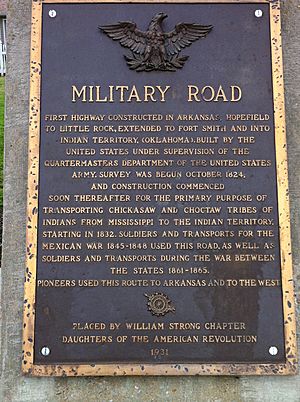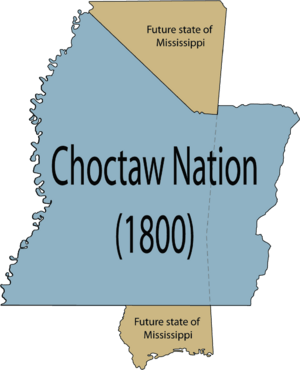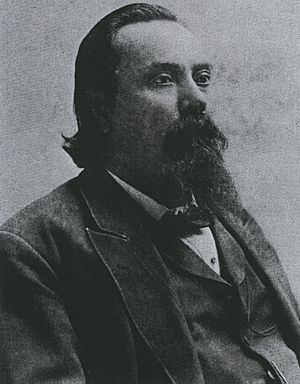Choctaw Trail of Tears facts for kids
Quick facts for kids Choctaw Trail of Tears |
|
|---|---|
| Part of the Trail of Tears | |
| [[File:tricky trichjh rdr6u85ew 3msw4de5tfrgyuhijoklp;-[-08u9t6j754ersdcvx,|frameless]] | |
| Location | United States |
| Date | 1831-1833 |
| Target | Choctaw people |
|
Attack type
|
Population transfer |
| Deaths | 2,500 |
| Perpetrators | United States Government |
| Motive | Expansionism |
The Choctaw Trail of Tears was a sad time when the United States government forced the Choctaw people to leave their homes. Their homeland was in what is now the Deep South (parts of Alabama, Arkansas, Mississippi, and Louisiana). They were made to move to lands west of the Mississippi River, in an area called Indian Territory (which is now Oklahoma). This happened in the 1830s.
A Choctaw leader once said that this forced move was a "trail of tears and death." Since then, the Choctaw people have grown and formed three main tribes. These are the Choctaw Nation of Oklahoma, the Mississippi Band of Choctaw Indians, and the Jena Band of Choctaw Indians in Louisiana.
Contents
What Was the Choctaw Trail of Tears?
The Choctaw people had to give up a huge amount of their land, about 11 million acres (4.5 million hectares). Their move happened in three main groups. The first group left in the fall of 1831. The second group moved in 1832, and the last group in 1833.
The Treaty of Dancing Rabbit Creek was a very important agreement. The U.S. Senate approved it on February 25, 1830. President Andrew Jackson wanted the Choctaw's removal to be an example for other Native American tribes.
George W. Harkins, a Choctaw leader, wrote a powerful letter. He said:
We leave with sadness, knowing that something wrong has been done. Will you show us kindness until all bad feelings are gone? Then we can trust our white friends again. This is the land of our ancestors, and their bones are here. They left this land as a sacred trust, and we have honored it. It is dear to us, but we cannot stay. My people are dear to me, and I must go with them. If I stayed and left them to struggle alone, I would not be worthy of being a Choctaw. I must go with them; my future is with the Choctaw people. If they suffer, I will suffer too. If they do well, I will be happy. I ask you again to treat us with kindness.
—George W. Harkins, George W. Harkins to the American People
The first group of Choctaw people who moved suffered the most. They faced many difficulties. The second and third groups had an easier time. They were able to plant their crops quickly. The forced moves continued even later in the 1800s. By 1930, only about 1,665 Choctaw people remained in Mississippi.
Treaties and Land Loss
The Choctaw Nation and the United States signed nine treaties between 1786 and 1830. The Treaty of Dancing Rabbit Creek was the last one. In this treaty, the Choctaw Nation agreed to give up the rest of their lands in the Southeast. Over time, European governments and the U.S. government took Choctaw land. They used treaties, laws, and even threats of war. Before the U.S. treaties, the Choctaw had also made agreements with Great Britain, France, and Spain.
The Choctaw people found European laws and diplomacy confusing. They especially found written agreements strange because they did not have a written language system. Their history was passed down by telling stories from one generation to the next.
During treaty talks, the three main Choctaw areas each had a "Miko" (chief) to speak for them. For example, during the Treaty of Natchez in 1793, Pushmataha was a chief for one of the areas. Spain was the first European country to claim Choctaw land. Then France made claims in the late 1600s. After 1795, the new United States also claimed Choctaw land.
The Choctaw signed the Treaty of Hopewell in 1786. This treaty did not take any land. But it was important because it gave the U.S. Congress the right to manage trade and "all their affairs."
The Treaty of Fort Adams was signed to give up land near the Yazoo River. The Choctaw thought giving up over 2 million acres (800,000 hectares) would be enough. But it was not. Six months later, the U.S. government asked for more land.
The Treaty of Mount Dexter was signed in November 1805. Under this treaty, the Choctaw gave up more land than ever before. At this time, the U.S. government wanted to get the Choctaw into debt through trading. Then, they would pay off the debt with their land. For the Mount Dexter Treaty, the Choctaw received $48,000 for 4.1 million acres (1.7 million hectares) of land. But they had to pay back $51,000 to the trading companies.
The Treaty of Doak's Stand was very important. In this treaty, the Choctaw gave up five million acres (2 million hectares) of land. In return, they were supposed to get thirteen million acres (5.3 million hectares) of land in Arkansas. But this caused problems. People in Arkansas felt abandoned by their government. They tried to stop the treaty from being approved. Even though it was approved, President Jackson had to find a new border line. This was to give the Choctaws the same amount of land without upsetting the white settlers.
Many Choctaw leaders were against the Treaty of Dancing Rabbit Creek. However, some leaders were convinced to sign it. Greenwood LeFlore and other "favored members" gained land by signing the treaty. Some historians believe that some Choctaw leaders agreed to the removal. They wanted to try and get the best deal from the U.S. government, which seemed determined to force them out.
American pressure to make the Choctaw give up their land continued. But the Choctaw fought as allies with the U.S. against the Creek in the Creek War of 1813. This war was partly a civil war within the Creek Nation. It happened while the U.S. was fighting Great Britain in the War of 1812. The Mississippi Band of Choctaw chose to stay in Mississippi. This was partly because their chief, Brig. General Pushmataha, was respected for his service. Many Choctaw fought in the War of 1812. Because of this, some Americans started to see them as allies.
When the Choctaw signed the Treaty of Fort St. Stephens, they thought it was a friendly meeting. In exchange for the land, the Choctaw received $6,000 each year for 20 years. They also received goods like guns, blankets, and tools worth $10,000.
| Treaty | Year | Land Given Up |
| Hopewell | 1786 | Not applicable |
| Fort Adams | 1801 | 2,641,920 acres (1,069,150 ha) |
| Fort Confederation | 1802 | 10,000 acres (4,000 ha) |
| Hoe Buckintoopa | 1803 | 853,760 acres (345,500 ha) |
| Mount Dexter | 1805 | 4,142,720 acres (1,676,500 ha) |
| Fort St. Stephens | 1816 | 10,000 acres (4,000 ha) |
| Doak's Stand | 1820 | 5,169,788 acres (2,092,130 ha) |
| Washington City | 1825 | 2,000,000 acres (810,000 ha) |
| Dancing Rabbit Creek | 1830 | 10,523,130 acres (4,258,550 ha) |
What Happened Next

About 15,000 Choctaw people, along with 1,000 enslaved people, moved to what became Indian Territory (later Oklahoma). This big move happened in three stages between 1831 and 1833. It included a very harsh winter blizzard in 1830–31 and a serious sickness called cholera in 1832. About 2,500 people died along the Trail of Tears.
Around 5,000 to 6,000 Choctaw people stayed in Mississippi after the first moves in 1831. For the next ten years, they faced many problems. They dealt with legal issues, being bothered, and being scared.
Unfair treatment was common. Some people who moved to Mississippi from other states had very negative views of the Choctaw. The forced removals continued even into the early 1900s. In 1903, about three hundred Mississippi Choctaws were convinced to move to Oklahoma.
Images for kids
See also
 In Spanish: Sendero de lágrimas choctaw para niños
In Spanish: Sendero de lágrimas choctaw para niños



